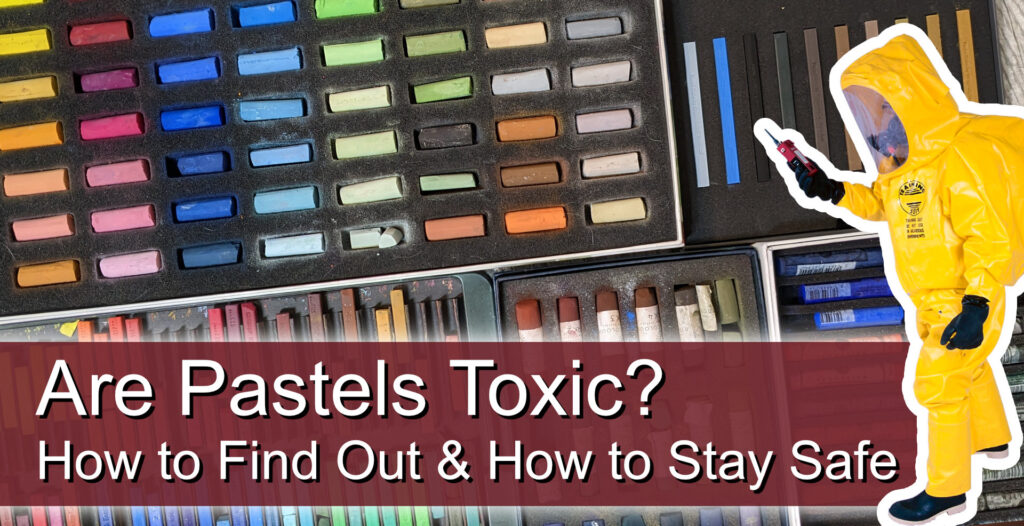
Are pastels toxic? The answer may surprise you!
Part of my personal mission to make pastels more approachable includes debunking misinformation. While pastels may have contained dangerous materials when they were first made hundreds of years ago, laws have been passed for consumer safety in the modern era.
In the U.S. there are three different methods of verifying safety of pastels (and art supplies in general). If you live in a different country, your region’s safety standards may be different.
Step 1: Search the ACMI Database
The quickest way to check if the pastel is toxic is to search the ACMI product database.
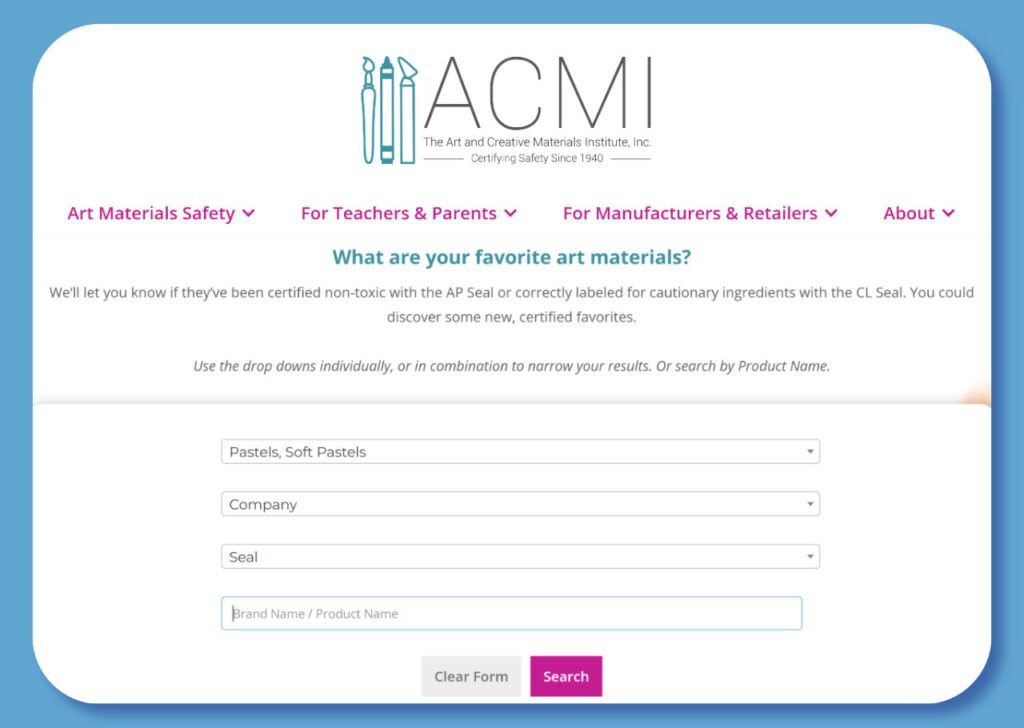
The Art and Creative Materials Institute Inc. (ACMI) and the passage of the Labeling of Hazardous Art Materials Act (LHAMA) led to the development of two easy-to-read seals that classify the art materials as Non-Toxic (AP) or Caution Label (CL). Manufacturers voluntarily submit their products for ACMI approval. An ACMI seal is unique to art materials sold in the U.S.
I used the ACMI database to look up Rembrandt soft pastels made by the brand Royal Talens. The entire line of pastels is rated AP (non-toxic)!
An important note about the database is located at the bottom of the search result. If the “Seal” column contains “#,” the product is certified to be non-toxic, but it may not have the AP seal present on the packaging. Therefore, it’s best to manually check through the database for your own supplies and supplies you plan to purchase to verify the ACMI status.
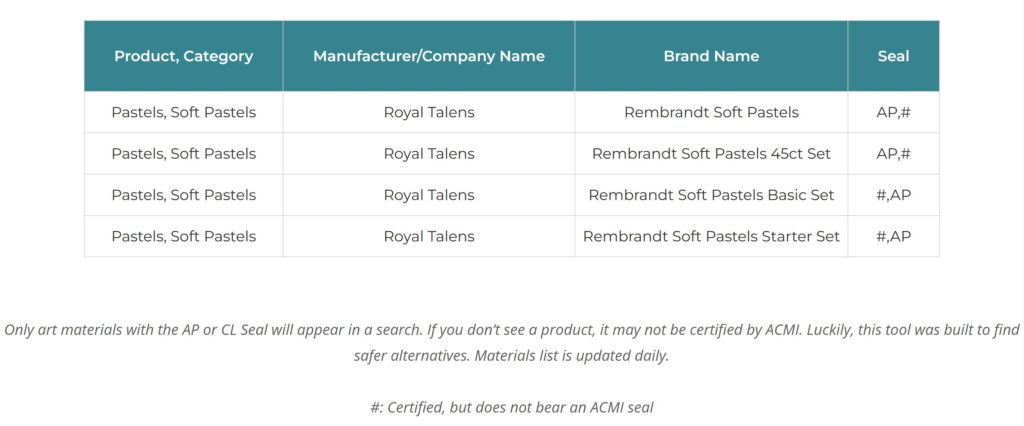
Products with the “CL” label contain toxic ingredients but may be used safely when appropriate precautions are taken. Note that some product lines may have some colors that are designated as “AP” and some as “CL”.
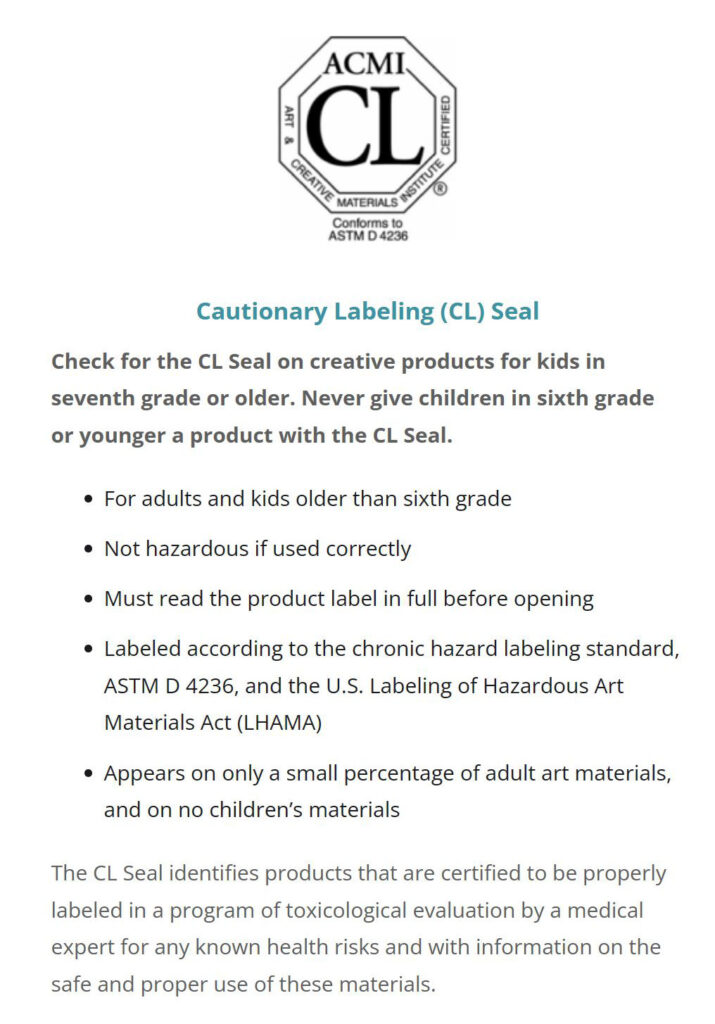
In addition to the instructions above, the outer packaging may have additional information (i.e. use in a well-ventilated area). For the pastels I personally own, the majority of the brands have the AP (Non-Toxic) seal.
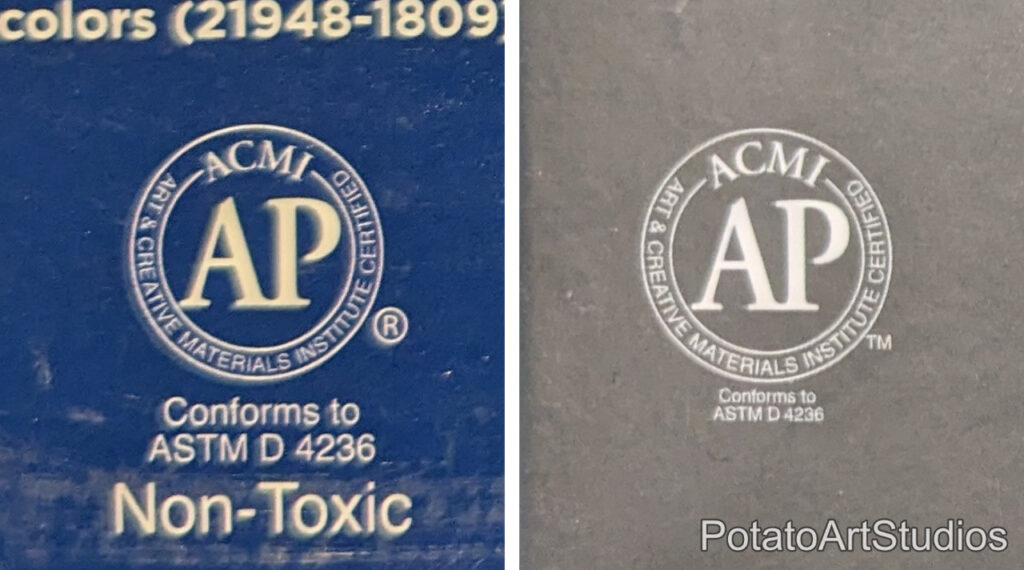
Step 2: Download the MSDS
Another method to identify the safety of pastels is to review the product MSDS. Material Safety Data Sheets (MSDS) also known as Safety Data Sheets (SDS) were standardized in 1986 by the Occupational Safety and Health Administration (OSHA), a U.S. federal agency. Toxic ingredients are required to be listed in the MSDS. Hazardous items require instructions for handling, storage, and exposure precautions.
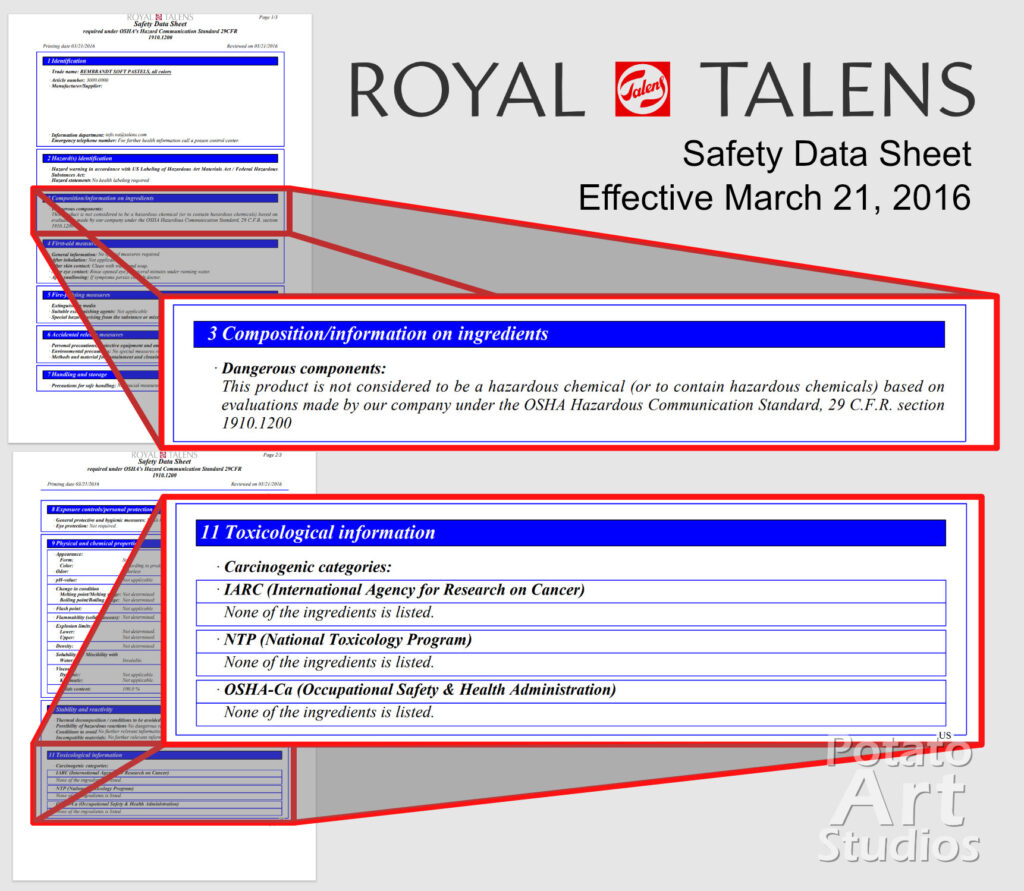
Note that MSDS information is specific to one product line from an art supply manufacturer. When purchasing art supplies from a distributor, the MSDS is often found in the Specifications, Download, or Product Information section near the item description. The MSDS can also be obtained by contacting customer service of the manufacturer.
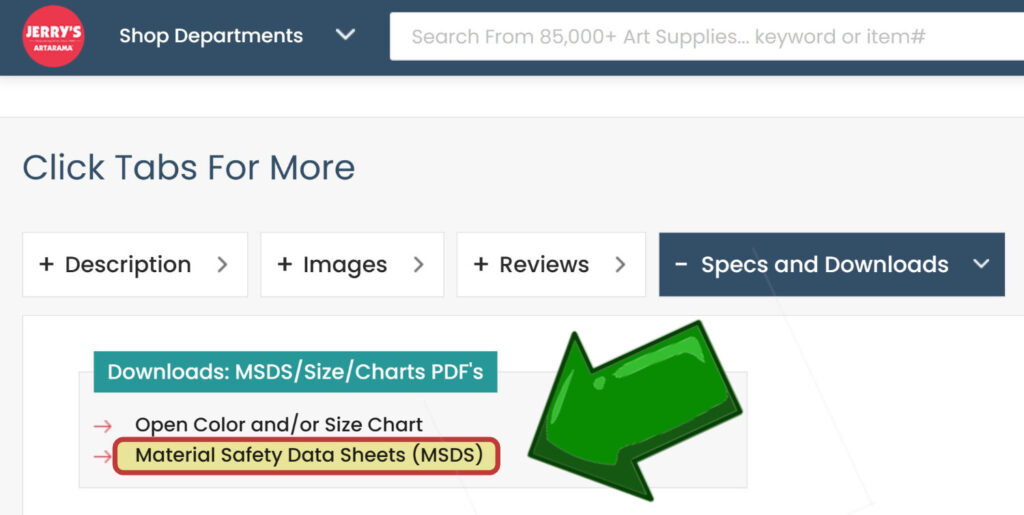
Step 3: Is There a CA Prop 65 Warning?
California Prop 65 (Safe Drinking Water and Toxic Enforcement Act of 1986) identifies chemicals that may cause cancer, birth defects, or reproductive harm when introduced into water systems. The entire list of chemicals can be viewed through the California Office of Environmental Health Hazard Assessment.
Because U.S. art retailers typically ship anywhere in the country, this includes the state of California. The entire list of toxic chemicals is a whopping 23 pages. When ordering art supplies, online retailers will often indicate if a product contains a Prop 65 chemical by a yellow triangle and exclamation point.
For Schmincke soft pastels, the SDS contains an appendix for Prop 65. All four ingredients (Titanium Dioxide, Nickel, Cobalt, and Carbon Black) are classified as known cancer-causing substances as of the latest Prop 65 chemical list.
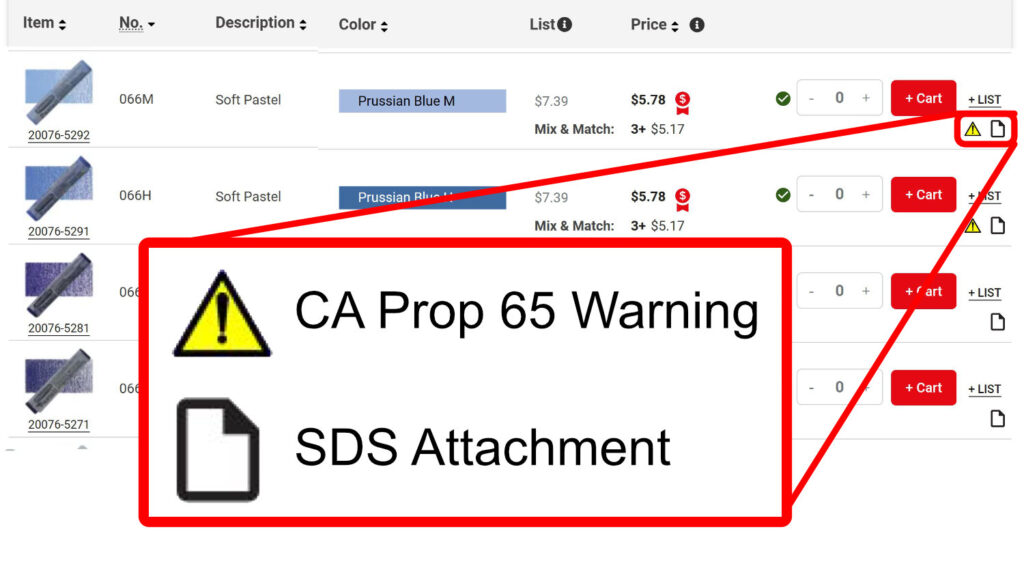
It’s important to note that a fraction of the 400 colors in the Schmincke range contain a Prop 65 chemical. Titanium dioxide is used for white. Nickel is used in some yellows and yellow-greens. Cobalt is used in several cool blues and blue-greens. And Carbon Black is included in two different blacks and a silver.
Prop 65 is seen as a very conservative measure for identifying toxic materials in art supplies. The information that is used to identify harmful chemicals are based on studies that expose animals to a specific item over extended periods of time and then analyzing the rate of cancer or birth defects from the exposed group to the control group.
For example, the ingredient Carbon Black is a carcinogen because of studies that observed a significant increase in lung cancer for rats exposed to particles of Carbon Black. However, one of the studies was based on 24 months of constant exposure. Will you, as an artist, expose yourself to 17,520 hours of Carbon Black dust over your lifetime? Probably not. But will knowing this fact help you change your art habits? Hopefully yes!
Common Sense Precautions
Even if a product is listed as non-toxic, inhaling or ingesting pastel dust is not ideal. Adapting your drawing habits by following the precautions:
- Avoid directly blowing on your pastel artwork. Instead, gently tap your artwork over a trash can to dislodge excess pastel dust.
- Minimize use of fans directly aimed at your pastel work.
- Use a combination of hard and soft pastel. Hard pastels typically generate less dust than soft pastel.
- Blend pastel mindfully. Blending large areas quickly will dislodge pastel into the air. Choose to blend sections of your drawing slowly and with deliberate motion.
- Create a ‘trough’ at the lip of your easel to catch pastel dust. Line the ‘trough’ with tape to catch the dust or routinely wipe/replace the trough when you see pastel dust accumulate.
- Routine surface cleaning. Use a damp paper towel to remove pastel that has settled on your table, easel, and surroundings periodically.
- Look into using a workable fixative as you draw. Fixatives will ‘seal’ existing layers of pastel on your support. Most fixatives will darken or change colors and should be used only after thoroughly testing it on your specific support and pastels.
- Always wash your hands after an art session and prior to eating or drinking. Avoid keeping food or drinks in your workspace.
Air Filtration Recommendations
Disclaimer: The items listed below are meant to be informational only and should not be taken as medical advice.
Even with the precautions listed above, artists with asthma or chronic lung conditions such as COPD may want to have additional protective equipment when working with pastels. If you notice coughing or irritation of the eyes, skin, lungs, or throat that develops while working with pastels, do not continue drawing. Consult your medical provider for recommendations on how to make your work area safer.
One of the benefits of COVID has been the accessibility of obtaining face coverings with high filtering capacities. Face coverings are best worn when they are tightly fitted to the face for an optimal seal. Face covering efficiency ratings were taken from this EPA article published in April 2021.
- Surgical Masks ($0.50-$1 USD): blue surgical masks often worn by doctors and nurses are 38-80% effective at filtering particles 0.3 microns or larger. These masks are available at most drug stores and pharmacies.
- Cloth masks/bandanas/homemade fabric face coverings ($2+ USD): 26-79% effective filtering rate. The large efficiency range is due to the differences in types of fabrics and number of layers of fabric used.
- N95 Mask ($2-5 USD): >95% effective at filtering particles 0.3 microns or larger. I personally purchase N95 masks at home improvement stores. They are sold individually or in packs in the paint aisle.
- Air Purifiers equipped with HEPA (High-Efficiency Particulate Air) filters ($80+ USD): Air Purifiers are expensive but are easier to implement than wearing a face covering. All HEPA air filters remove 99.97% of airborne particles 0.3 microns or larger. An Air Purifier should be chosen based on the size of the art workspace. The HEPA filter will need to be replaced according to the manufacturer instructions (every 6 or 12 months).
So what to make of all this?
In writing this post, I realize that the amount of information is probably overwhelming to the average artist. But knowing how to find the information and more importantly knowing how to interpret this information will create educated artists.
Does this mean I’ll be throwing away any art supplies marked with the ACMI Caution Label or CA Prop 65 warning? Nope! But I will likely wear a face covering if I’m creating a large drawing.
Most art mediums will have solvents or fixatives that will be considered toxic. Everyday activities such as driving a car also comes with hazards. Risks are part of life, and you can choose risk mitigating actions such as wearing protective equipment (a face covering) and purchasing tested non-toxic materials.
Do you live outside the U.S.? Share your country’s safety standards for art supplies in the comments. If you live in the U.S., I hope the ACMI database and Safety Data Sheet overview is helpful with your next art supply purchase.
-Lauren